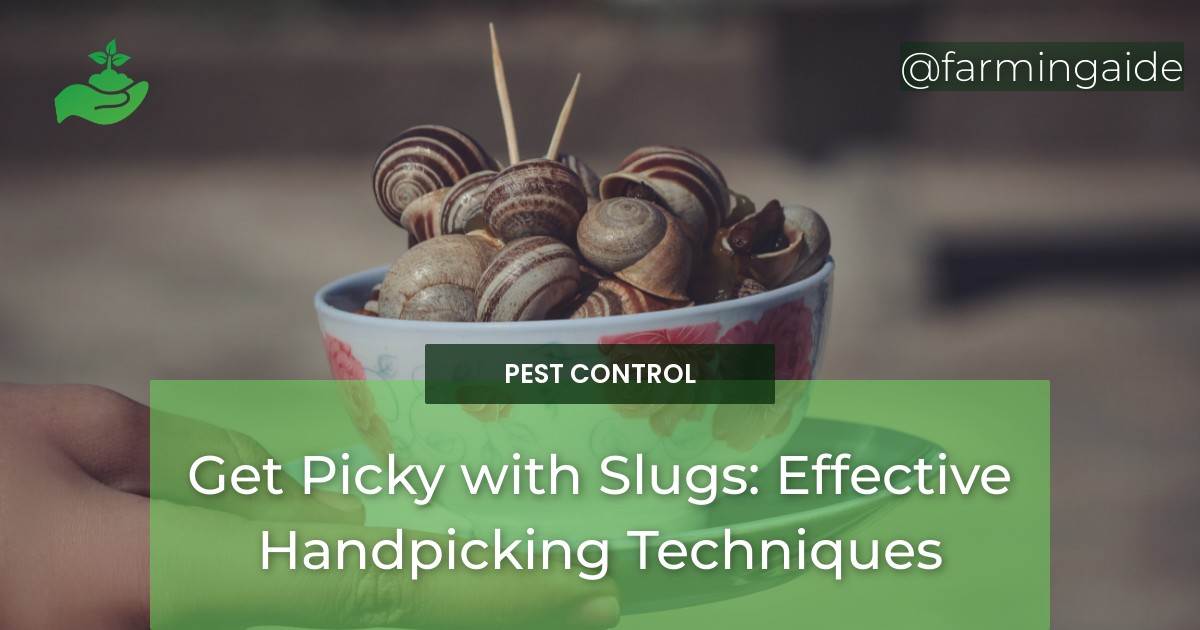Are you tired of battling slug infestations in your garden? If you’re looking for an effective and environmentally friendly way to control these garden pests, handpicking might be the solution you’ve been searching for. Handpicking slugs allows you to directly target and remove them from your plants, reducing the need for chemical pesticides and minimizing harm to beneficial insects.
In this article, we look at some Effective Handpicking Techniques to Control Slugs in your gardens.
Table of Contents
When to handpick Slugs
Early morning or late evening
Slugs are most active during the early morning or late evening when the temperatures are cooler and the humidity is higher. This is the ideal time to handpick them as they are more likely to be out and about.
On damp and cloudy days
Slugs thrive in damp conditions, so picking them on damp and cloudy days when the moisture levels are high will increase your chances of finding them.
After rain showers
After a rain shower, slugs tend to come out from their hiding spots to feed on plants. Take advantage of this opportunity to handpick them.
Tools and methods for handpicking
Equipping yourself with the right tools will make handpicking slugs a breeze.
Gloves
Wear gloves to protect your hands from the slime and potential bacteria carried by slugs.
Headlamp or flashlight
Using a headlamp or flashlight will provide visibility during nighttime slug picking sessions.
Bucket of soapy water
Prepare a bucket of soapy water to drown the picked slugs. The soap helps to break down their outer layer, ensuring they cannot escape.
Tweezers or tongs
Use tweezers or tongs to safely pick up slugs without directly touching them.
Plastic bags or containers
Keep plastic bags or containers handy to collect the picked slugs for disposal.
Garden rake or hoe
Use a garden rake or hoe to disturb slug hiding spots and expose them for easier picking.
Proper disposal of picked slugs
Once you have handpicked the slugs, it’s important to dispose of them properly to prevent them from returning to your garden.
Drowning in soapy water
Place the picked slugs into the bucket of soapy water to ensure they are fully submerged and unable to survive.
Freezing
If you have a freezer available, you can place the collected slugs in a sealed bag and freeze them to effectively kill them.
Burying in garden compost
Another option is to bury the collected slugs in your garden compost. Over time, they will decompose and contribute to the nutrient content of the compost.
Feeding to chickens or birds
If you have chickens or birds, you can offer the collected slugs as a tasty treat. They will happily consume them, benefiting from the protein-rich snack.
Cleaning hiding spots to prevent slug infestation
Preventing slug infestations is key to maintaining a healthy garden. By eliminating their hiding spots, you can significantly reduce their population.
Removing garden debris and leaf litter
Clear away any garden debris and leaf litter where slugs love to hide. Keeping your garden clean and tidy will discourage them from settling in.
Clearing overgrown vegetation
Overgrown vegetation provides ample hiding places for slugs. Regularly trim and clear out any dense vegetation to minimize their hiding spots.
Regularly turning and aerating the soil
Slugs hide in moist soil, so regularly turning and aerating the soil will expose them to drying conditions, making it unfavorable for their survival.
Using copper barriers or diatomaceous earth
Creating barriers made of copper or applying diatomaceous earth around vulnerable plants can act as deterrents and physical barriers, preventing slugs from reaching your plants.
Nighttime slug picking
Picking slugs during nighttime can be an effective strategy, especially if you have a large slug population.
Benefits of picking slugs at night
At night, slugs are more active and easier to locate. Additionally, other nocturnal pests might be less active, allowing you to focus solely on slugs.
Using a headlamp or flashlight for visibility
Using a headlamp or flashlight will ensure you can see and pick slugs accurately, even in the dark.
Locating slugs in their feeding areas
Identify the areas in your garden where slugs are causing the most damage. These are the spots where they are likely to be feeding, making them prime locations for picking.
Being cautious of other nocturnal pests
While picking slugs at night, be aware of other nocturnal pests like snails, earwigs, and slaters. Use caution to avoid accidentally harming beneficial insects.
Frequency required for effective slug control
To effectively control slug populations, regular and consistent handpicking is necessary.
Daily or every few days during peak activity
During peak slug activity periods, such as after rainfall or in humid weather, handpick slugs daily or every few days to stay ahead of their reproductive cycles.
Regular inspections during favorable conditions
Even during less active periods, it’s important to conduct regular inspections to catch any slugs that might be starting to establish themselves in your garden.
Adjusting frequency based on slug population
Monitor the slug population and adjust your handpicking frequency accordingly. If the population is low, you may need to handpick less frequently, while higher populations may require more frequent picking.
Pros and cons of handpicking slugs
Pros:
- Environmentally friendly
- Cost-effective
- Reduces the need for chemical pesticides
Cons:
- Time-consuming
- Labor-intensive
- Ineffective for large infestations
Handpicking slugs offers several advantages, such as being environmentally friendly, as it avoids the use of chemical pesticides. It is also a cost-effective method that can save you money in the long run. However, it is important to note that handpicking can be time-consuming and labor-intensive, especially if you have a large garden or a significant slug population. Additionally, for severe infestations, handpicking alone may not be enough to effectively control the slug population.
By implementing these effective handpicking techniques to control slugs and incorporating them into your regular garden maintenance routine, you can keep your plants healthy and slug-free without relying on harmful chemicals or pesticides.


